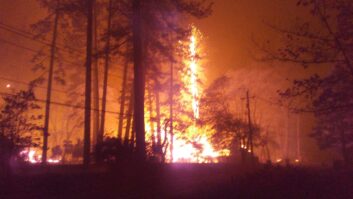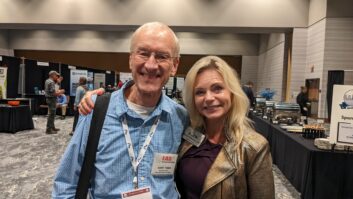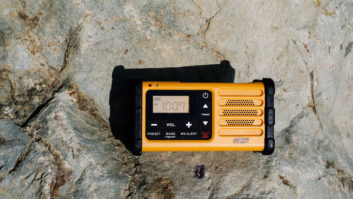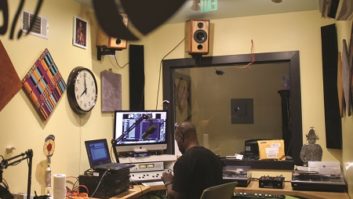
Richard F. Arsenault thinks he has a solution to problems of AM broadcast reception. His idea may go no farther than the daydream stage; but it fits well into our ongoing coverage of the technical and business health of AM in the United States.
Arsenault is a consultant who most recently garnered attention for a proposal to allow earlier pre-sunrise operation; the FCC has been taking comments on that. He now appears to be feeling his oats and has petitioned the commission for a somewhat bigger change, namely a significant power increase for AM stations. We’re not talking about digital stations here (as in the recent FM IBOC power hike), but about virtually all AM analog facilities.
“AM standard broadcast radio service has suffered serious degradation of coverage over recent decades due to increased interference from new technologies,” he writes.

Bring back the good old days: ‘We have watched the AM service degrade due to the increase in interference for too long,’ Richard Arsenault believes. ‘We must return AM radio service to comparable and usable coverage levels of the past.’ iStockphoto/Anthony Ladd “The development and use broadband over power lines (BPL), computers and other digital computing devices, appliances like microwave ovens, the common use of energy efficient fluorescent lighting with integrated solid-state switching circuitry and virtually all other electronic devices and services have all significantly increased the sum amount of electromagnetic interference to the reception of AM radio to the point of near uselessness in many areas were AM stations once provided adequate service to the general public.”
He argues that the primary factor limiting reception during daylight hours has become interference from electronic devices and power lines, surpassing that caused by other stations.
“The commission established service contours and interference protection ratios at an earlier time when interference from existing electrical equipment was minimal and interference from digital electronics did not exist,” he believes.
“At that time, the protected contours and the interference ratios made sense. Unfortunately, they were calculated without available foresight of the future digital technological revolution.
“The current protected daytime service areas for AM stations are generally out to the 0.5 mV/m contour for all classes of AM stations, with exception of Domestic Class A AM stations, which are protected to 0.1 mV/m contour,” he continues.
“In reality, very few radios are capable of satisfactory reception at these lower signal levels because of the overwhelming degree of electronic and digital interference. What we currently have are AM broadcast stations adequately protecting each other in the AM radio band, but these same stations are not receiving protection from the intense electromagnetic interference from unintentional sources, making the current protected service contours of AM broadcast stations of minimal value.
“Accordingly, defining adequate rural service out to the 0.5 mV/m protected contour needs to be rethought in light of the fact that the sources of electromagnetic interference are part of our current lifestyle and will only get worse.”
In his view, the solution is to allow virtually every AM in the United States the option of participating in a substantial across-the-board daytime power increase.
“Increasing power during daytime hours would solidify the daytime coverage of all participating stations and would not change the interference ratios between these same participating stations.”
He would like to see a 10-fold power increase and, if that’s not possible, four-fold. “Ultimately, anything less than a doubling of power (3 dB) would be almost insignificant.”
Go for it
Adoption of the full power increase, Arsenault thinks, “would solidify AM radio, penetrate virtually every remote area, break through all but the worst interference and fill most AM radio dials with numerous selections of strong stations instead of limited or no choices lost in static.”
It would expand the coverage of AM stations and solidify coverage of stations within their service areas. “None of the participating stations would lose coverage, as co-channel and adjacent channel stations that elect to maximize power would not see any change in their interference ratios; but all participating stations would dramatically improve overall coverage by improving their ratios between the desired radio signals and the undesired electronic interference.”
Arsenault suggests a grace period would be established to allow stations time to install upgrades; and only a written letter to the commission would be needed, specifying the degree of power increase and date of implementation. “All future interference calculations could be made utilizing the previous lower power levels of all stations, simplifying future allocation issues,” he continued.
He acknowledges concerns involving stations near Canada and Mexico and a few others “where a saltwater interference path to foreign stations exists,” but believes that “the grand majority of listeners to domestic AM broadcast stations will benefit by this request if adopted. The few stations in the border areas with required daytime protection to foreign stations could benefit by opting to use of a directional antenna pattern or a change in the existing daytime antenna pattern, or alternately possibly use a partial power increase.”
Arsenault would limit his power hike to the daytime hours “due to interfering nighttime interference restraints with foreign broadcasters,” but nighttime interference to stations in Canada, Mexico and other nations could be considered later “unless the commission can resolve these issues in a timely manner with each of these countries.”
No static at all?
Arsenault started his radio career in the 1970s as a DJ on a commercial FM in Vineland, N.J. He told me he was fascinated with technology as a youngster and assembled small radio transmitters and receivers for school science projects and out of personal interest.
“I quickly realized that the highest class FCC license, the First Class Radiotelephone at that time, would be my ticket to expand my radio career, so I picked up a few books and studied until the book covers fell off.”
In the early 1980s he worked as a chief engineer for radio and at Lamar University in Beaumont, Texas, and did work for Jules Cohen and Associates, the legendary consulting firm.
“In the mid and late 1980s I designed and assembled a few radio stations and prepared a number of FCC applications for power increases, including directional antennas and short-spaced radio facilities,” he said. “I also hosted a Saturday night oldies show and did some radio sales.”
He filed his first petition for rulemaking in 1989, addressing a plan to allow existing daytime standalone stations an opportunity to use low-power FM in order to provide full-time coverage to their communities. In the early 1990s, he was the sole engineer for 14 AM and FM stations; he went on to purchase WREY(AM) a 1,000 watt station in Millville, N.J., which he managed for six years (it is now WMVB). This was an important time in the development of his views.
“Managing the sales, programming, staff and community involvement of a stand-alone AM station had to be the biggest and toughest challenge of my career, in light of the fact that all competitors were either FM or had AM/FM combos, and the local market was already overshadowed by major-market Philadelphia stations. I had to get creative and expand the local community connection.”
His business now is in offering technological and business consulting services to radio broadcasters who want to optimize their signals and grow their stations. His website is www.radio-broadcast-engineer.com.
I suspect Arsenault will succeed on his earlier petition to move up pre-sunrise authorization time. It may be harder to gain as much traction with an ambitious power hike but I commend him for bringing the idea up and I hope it will be taken seriously. This may not yet be a comprehensive technical plan but it can start the conversation.
“I realize that there are details that will need to be addressed before implementation,” he wrote. “But more importantly, this petition should open discussion on this concept … The time to get the static out of AM radio is past due. We have watched the AM service degrade due to the increase in interference for too long. We must return AM radio service to comparable and usable coverage levels of the past.”
Tell me what you think at[email protected]. Arsenault welcomes your thoughts too at[email protected].












